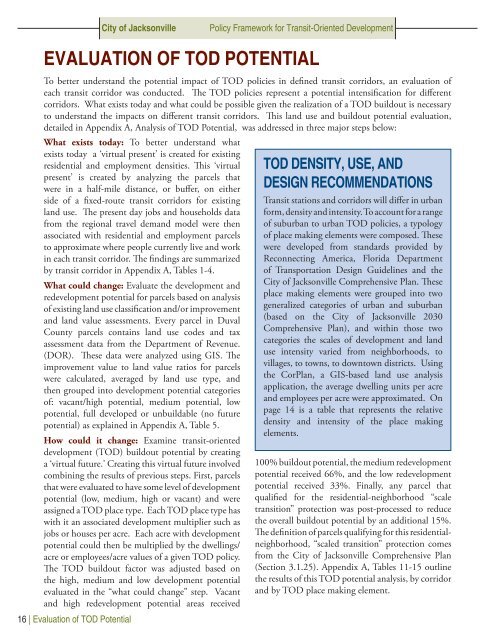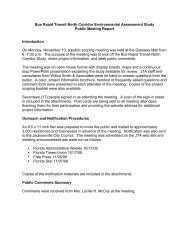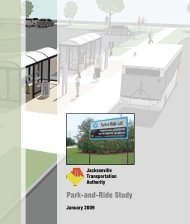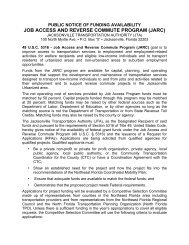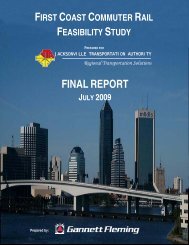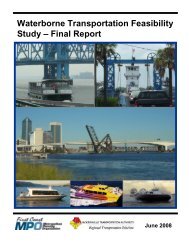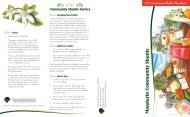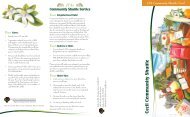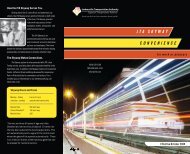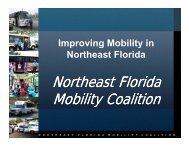Policy Framework - Jacksonville Transportation Authority
Policy Framework - Jacksonville Transportation Authority
Policy Framework - Jacksonville Transportation Authority
You also want an ePaper? Increase the reach of your titles
YUMPU automatically turns print PDFs into web optimized ePapers that Google loves.
City of <strong>Jacksonville</strong><br />
<strong>Policy</strong> <strong>Framework</strong> for Transit-Oriented Development<br />
Evaluation of TOD Potential<br />
To better understand the potential impact of TOD policies in defined transit corridors, an evaluation of<br />
each transit corridor was conducted. The TOD policies represent a potential intensification for different<br />
corridors. What exists today and what could be possible given the realization of a TOD buildout is necessary<br />
to understand the impacts on different transit corridors. This land use and buildout potential evaluation,<br />
detailed in Appendix A, Analysis of TOD Potential, was addressed in three major steps below:<br />
What exists today: To better understand what<br />
exists today a ‘virtual present’ is created for existing<br />
residential and employment densities. This ‘virtual<br />
present’ is created by analyzing the parcels that<br />
were in a half-mile distance, or buffer, on either<br />
side of a fixed-route transit corridors for existing<br />
land use. The present day jobs and households data<br />
from the regional travel demand model were then<br />
associated with residential and employment parcels<br />
to approximate where people currently live and work<br />
in each transit corridor. The findings are summarized<br />
by transit corridor in Appendix A, Tables 1-4.<br />
What could change: Evaluate the development and<br />
redevelopment potential for parcels based on analysis<br />
of existing land use classification and/or improvement<br />
and land value assessments. Every parcel in Duval<br />
County parcels contains land use codes and tax<br />
assessment data from the Department of Revenue.<br />
(DOR). These data were analyzed using GIS. The<br />
improvement value to land value ratios for parcels<br />
were calculated, averaged by land use type, and<br />
then grouped into development potential categories<br />
of: vacant/high potential, medium potential, low<br />
potential, full developed or unbuildable (no future<br />
potential) as explained in Appendix A, Table 5.<br />
How could it change: Examine transit-oriented<br />
development (TOD) buildout potential by creating<br />
a ‘virtual future.’ Creating this virtual future involved<br />
combining the results of previous steps. First, parcels<br />
that were evaluated to have some level of development<br />
potential (low, medium, high or vacant) and were<br />
assigned a TOD place type. Each TOD place type has<br />
with it an associated development multiplier such as<br />
jobs or houses per acre. Each acre with development<br />
potential could then be multiplied by the dwellings/<br />
acre or employees/acre values of a given TOD policy.<br />
The TOD buildout factor was adjusted based on<br />
the high, medium and low development potential<br />
evaluated in the “what could change” step. Vacant<br />
and high redevelopment potential areas received<br />
16 | Evaluation of TOD Potential<br />
TOD Density, Use, and<br />
Design Recommendations<br />
Transit stations and corridors will differ in urban<br />
form, density and intensity. To account for a range<br />
of suburban to urban TOD policies, a typology<br />
of place making elements were composed. These<br />
were developed from standards provided by<br />
Reconnecting America, Florida Department<br />
of <strong>Transportation</strong> Design Guidelines and the<br />
City of <strong>Jacksonville</strong> Comprehensive Plan. These<br />
place making elements were grouped into two<br />
generalized categories of urban and suburban<br />
(based on the City of <strong>Jacksonville</strong> 2030<br />
Comprehensive Plan), and within those two<br />
categories the scales of development and land<br />
use intensity varied from neighborhoods, to<br />
villages, to towns, to downtown districts. Using<br />
the CorPlan, a GIS-based land use analysis<br />
application, the average dwelling units per acre<br />
and employees per acre were approximated. On<br />
page 14 is a table that represents the relative<br />
density and intensity of the place making<br />
elements.<br />
100% buildout potential, the medium redevelopment<br />
potential received 66%, and the low redevelopment<br />
potential received 33%. Finally, any parcel that<br />
qualified for the residential-neighborhood “scale<br />
transition” protection was post-processed to reduce<br />
the overall buildout potential by an additional 15%.<br />
The definition of parcels qualifying for this residentialneighborhood,<br />
“scaled transition” protection comes<br />
from the City of <strong>Jacksonville</strong> Comprehensive Plan<br />
(Section 3.1.25). Appendix A, Tables 11-15 outline<br />
the results of this TOD potential analysis, by corridor<br />
and by TOD place making element.


